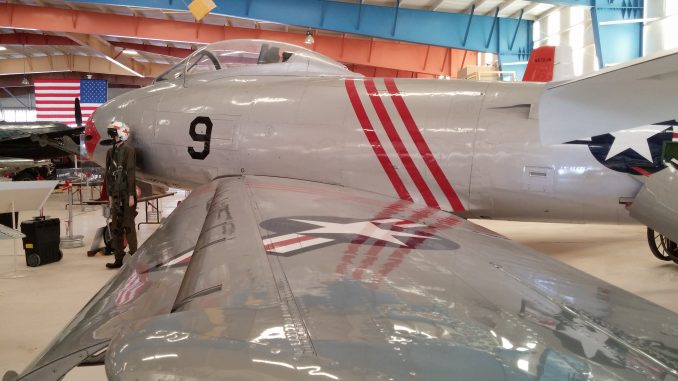
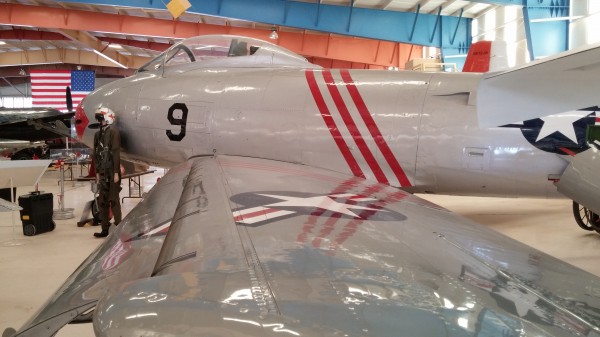
By Elena Early DePree
The “FJ-2 Fury” was the Navy version of the F-86. These airplanes were delivered to the Navy in the autumn of 1952. After the Korean Conflict, the construction contract was reduced to 200 and all “FJ-2s” were assigned to the Marine Corps. Elena Early DePree takes a closer look to the history and development of the this icon jet and the aircraft exhibited at the War Eagle Air Museum in Santa Teresa, NM.
The early days of the Jet Age were a fascinating period in aviation history. As in many other aspects of of advanced technology aircraft, German designers in Adolf Hitler’s Third Reich pointed the way to the future in the waning days of WWII with the Messerchmitt Me-262 Schwalbe (Swallow), a high performance twin-jet aircraft that handily outflew everything else in the air at that time. But German factories, dispersed around the diminishing Reich to avoid relentless Allied bombing raids, never made enough Me-262’s to affect the outcome of the War. Also, Hitler’s irrational insistence that this quintessential fighter be used as a fighter-bomber instead meant that the Schwalbe never lived up to its promise.
In America, both the U.S. Army Air Corps and the Navy developed jets during the War, but none of them saw combat. The Bell Xp-59 Airacomet, the nation’s first jet aircraft, first flew on October 1, 1942, but never went into production because of disappointing performance. Lockheed’s XP-80 Shooting Star, which went from concept to flying prototype in only 143 days and first flew on January 8, 1944, was a direct response to the Me-262, which had begun to show up in astonished Allied aircrews’ combat reports. But developmental problems, including several crashes, delayed its service entry until after the War was over.
Meanwhile, the more-conservative Navy, not yet ready to depend on the new-fangled jet engines, ordered the Ryan XFR-1 Fireball in February 1943. The XFR-1 had both a conventional radial piston engine and a turbojet. First taking to the air sans jet engine on the June 25, 1944, the XFR-1 had poor longitudinal stability and lacked structural strength. The first three prototypes all crashed during flight testing.
The next Navy jet fighter looked alot like the Fireball, but rather than ending up as an aeronautical oddity, as did the Ryan design, it spawned a long-lived and historically significant line of very successful air superiority and ground attack aircraft.
On September 5, 1944, the Navy Bureau of Aeronautics issued a specification for a new single-seat, carrier-based jet fighter. Two contracts came out of this specification. The Vought Aeronautics Company received one for the XF-6U Pirate (a dead end design so underpowered that it bore the nickname “Groundhog”). The Navy also contracted with North American Aviation (NAA), of Downey, CA, for its NA-134, even though the company had no experience with the wet, salty, hostile environment of carrier aircraft. The NA-134 was not only the NAA’s first jet- it was the first aircraft of any type that the company had designed for the Navy. Powered by a General Electric J-35 axial-flow turbojet, the NA-134 was stubby and straight-winged, like the XFR-1 and the XF-6U. The Navy thought- wrongly, as it turned out- that straight wings were essential for good low-speed handling during carrier landings. The Navy ordered three NA-134’s, then designed the XFJ-1 Fury, on May 28, 1945.
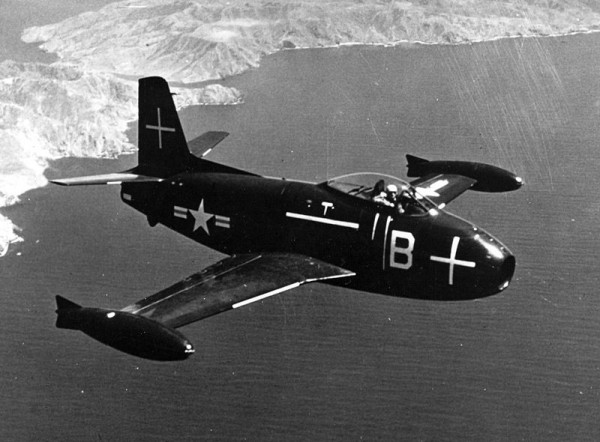
The first XFJ-1 flew on September 11, 1946. The flight test program went so well that the Navy ordered 100 production FJ-1’s before the tests finished, with deliveries starting in October 1947. But by then, the Navy had to cut its order to 30 aircraft, partly because the continuing headlong rush of jet technology meant its current designs were obsolete. An FJ-1 of Squadron VF-5A made the Navy’s first operational jet carrier landing when it snagged the #1 arresting wire on the USS Boxer at sea on March 10, 1948. In September, an FJ-1 won the Bendix Trophy Race in the Jet Class, flying from Van Nuys, CA to Cleveland, OH, in four hours 11 minutes, averaging 489.53 miles per hour. Still, despite briefly being the fastest airplanes in the sky, the Navy’s first operational jets were outdated even as NAA was still building them. The FJ-1 had a lifetime of just 14 months before transfers of still new aircraft to Naval Reserve units began. By 1953, no FJ-1s were flying anywhere. The Navy had something much better to replace them with.
Some sources say NAA FJ-2, the swept-wing FJ-1 follow-on, owed its design to the company’s F-86 Sabre. Others claim it’s the other way around. The most accurate account is the one that the late Charles Darwin (1809-1882) would appreciate. In the same sense that humans did not “descend” from apes, as Darwin’s research proved, but rather share a common ancestor with them, it seems that neither the FJ-2 nor the F-86 “descended” from the other. Instead, both aircraft “species” simply shared a common ancestor.
That ancestor was the NA-140. While developing the FJ-1 for the Navy, NAA was also working on a jet fighter for the Air Force called the NA-140. Slender and stream-lined, the NA-140 had sharply swept wings and tail surfaces. While the Navy had originally considered the NA-140 for its first jet, it had opted instead for the less radical NA-134 because of its concern about the stability of swept wings on carriers. But two factors set the stage for a new NAA fighter for the Navy that bore virtually no relation to its first. Since the FJ-1 was being phased out, the Navy needed a replacement. Meanwhile, the NA-140 had transmogrified into the outstanding F-86 Sabre. Data from F-86 flight tests showed that swept-wing aircraft could operate from aircraft carriers. So the Navy contracted for a “navalized” NA-140, and ordered three prototypes, designated XFJ-2s, on March 8, 1951.
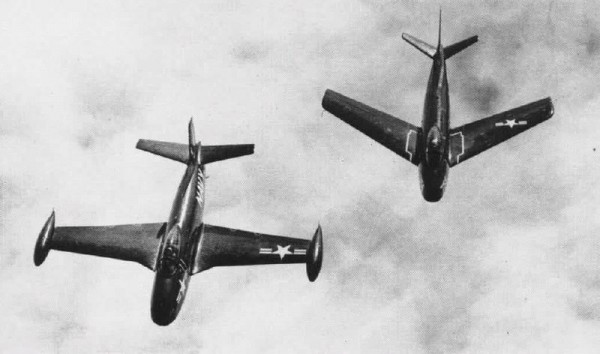
The prototypes were basically F-86E’s fitted with catapult fittings, an arresting hook, and a longer nose wheel strut. The first one flew on December 27, 1951. Carrier compatibility tests went reasonably well so the Navy ordered 300 FJ-2s. But by the time the 200th one got to its fleet unit in September 1954, the Korean War had ended, thus also ending the Navy’s pressing need for more combat aircraft.
As much of an improvement as the FJ-2 was over the FJ-1, it still left alot to be desired in the power department. In March 1952, just months after the FJ-2 first flew, NAA started working on the FJ-3, with a 7,720-pound-thrust Wright J-65-W-4 engine–a license built version of the British Armstrong-Siddeley Sapphire turbojet. The Navy awarded NAA a contract for 389 FJ-3s the next month, even though the first prototype did not fly until July 3, 1953, more than a year later. NAA delivered 538 of them to 12 Navy squadrons from 1954 through the end of 1956.
Production FJ-3’s resembled FJ-2s except that they had a bigger intake to feed more air to the more powerful jet engine. Another difference was the FJ-3s gray-over-white paint scheme rather than the FJ-2’s overall gloss blue. FJ-3s also had larger fuel tanks, wing “fences”, a detachable in-flight refueling probe, and underwing pylons for bombs or missiles.
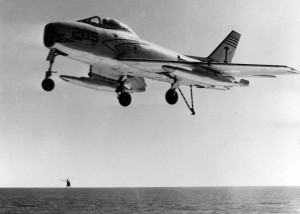
FJ-3s and -3Ms, equipped 19 Navy and 4 Marine squadrons. An FJ-3 of VF-21 made Naval aviation history as the first aircraft to land aboard the USS Forrestal, the Navy’s first supercarrier, and Furies helped pioneer the mirror landing system on angled-deck carriers. NAA’s objective for the final Fury variant, the FJ-4, was to increase the aircraft’s range without sacrificing performance. The FJ-4 looked much like the -3, but was actually a completely new design, with a shorter but fatter fuselage, a thinner but larger wing, a taller rudder, an “all-flying” tail, and 50% more fuel capacity. The prototype flew for the first time at NAA’s Columbus, OH facility on October 28, 1954. By May 1958, when the last one left the assembly line, NAA had made 147 FJ-4s and 217 FJ-4Bs ( a modified FJ-4 that could deliver nuclear weapons). Meanwhile, FJ-3s continued in service, overlapping with the new FJ-4s. Most went to Naval and Marine Reserve units by 1959. FJ-4Bs reportedly flew a few air strikes in Laos in 1962, but other than that unconfirmed report, no Furies ever saw combat. By the end of 1962, the Navy had relagated all of them to Reserve unit and they were completely retired by the mid- 1960’s.
Perhaps no other aircraft better illustrates the development of early American jet fighters than the Fury. Beginning life as a simple, conservative design with a marginal performance, the FJ series morphed, in a series of measured, deliberate steps driven by the pace of increasing technical knowledge of jet engines and advanced aerodynamics, into a powerful, successful air superiority and ground attack aircraft. Furies served as testbeds for jet operations on carriers and helped develop gun and missile armament systems, advanced electronics and nuclear weapons delivery capabilities for the Navy. All in all, the lasting legacy of North American Aviation’s first jet and first Navy fighter is a very impressive one.
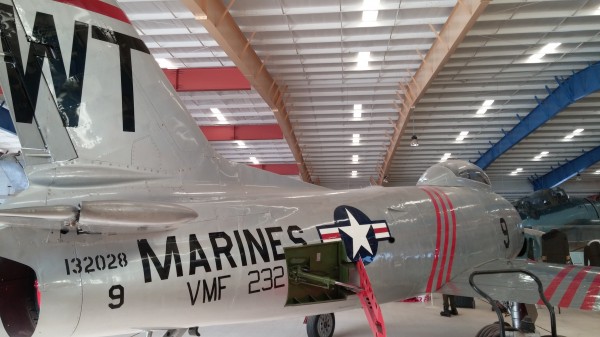
The War Eagles FJ-2 Fury was accepted by the US Navy on April 21, 1954 at the NAA Plant in Columbus, OH. It was flown to NAS Alameda, CA where she served for a short time with FASRON-B prior to being assigned to Marine Fighter Squadron VMF-232 at USMC Station Kaneohe, HI., in November 1954. She served until November 1956, whereupon she was returned to the Navy and was assigned to FASRON-B in Barbers Point, HI until she was returned to NAS Alameda in March 1957. She was then stricken from inventory in July 1958, having flown a total of 744 hours during an active operational service of 78 months.
This static airframe was restored by John Muzala, of Pacific Fighters in Chino, CA and purchased by John MacGuire for present museum display in 1989.
The War Eagles Air Museum is dedicated to collecting, restoring and displaying historic aircraft of the World War II and the Korean Conflict eras. This unique Museum pays special tribute to military aviation and reminds us all of the significant role these airplanes, their pilots and support crews played in securing our freedom.


Be the first to comment
Graphic Design, Branding and Aviation Art